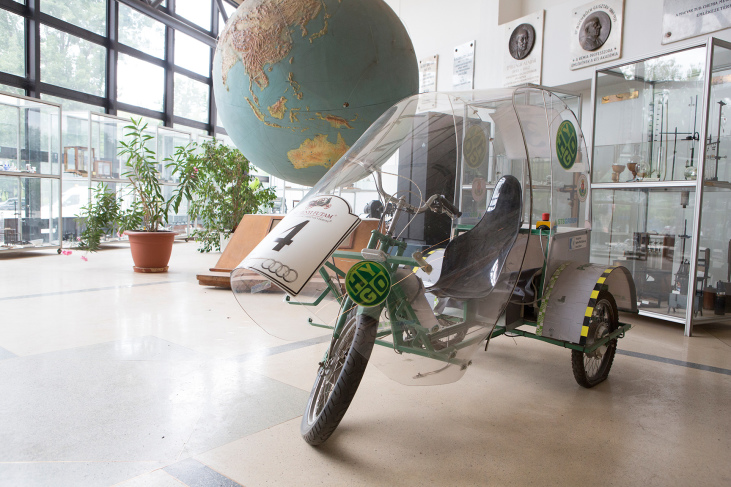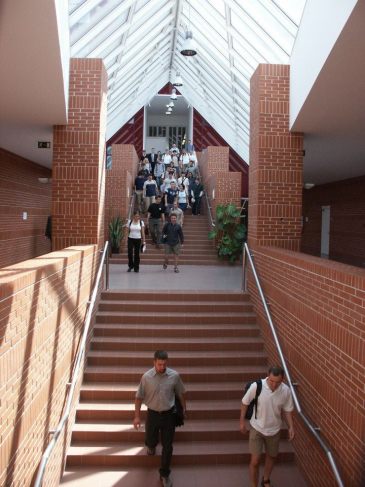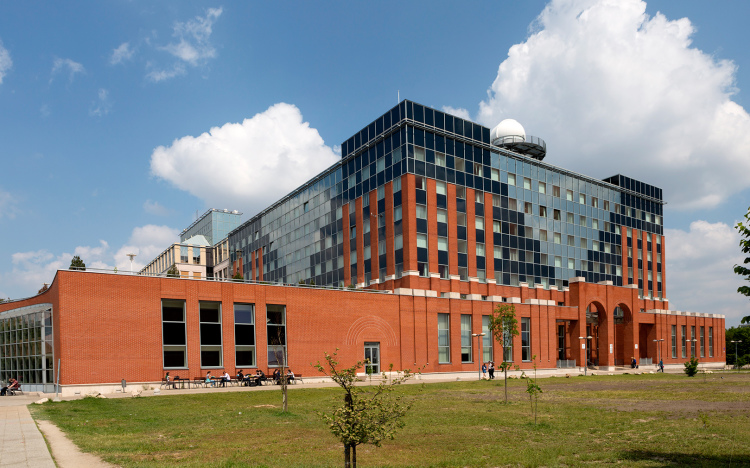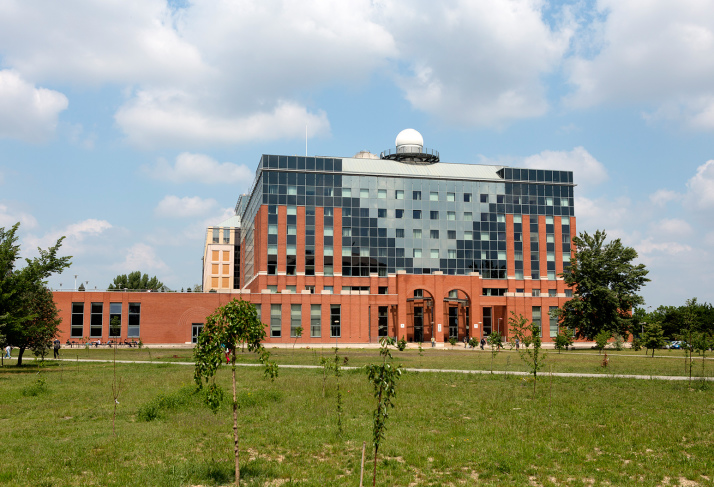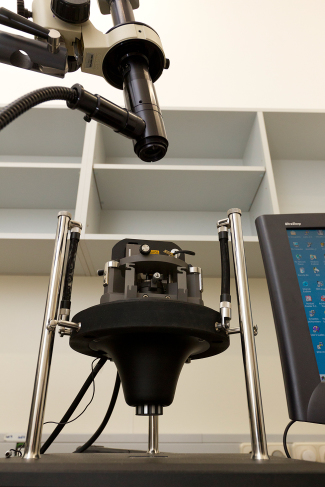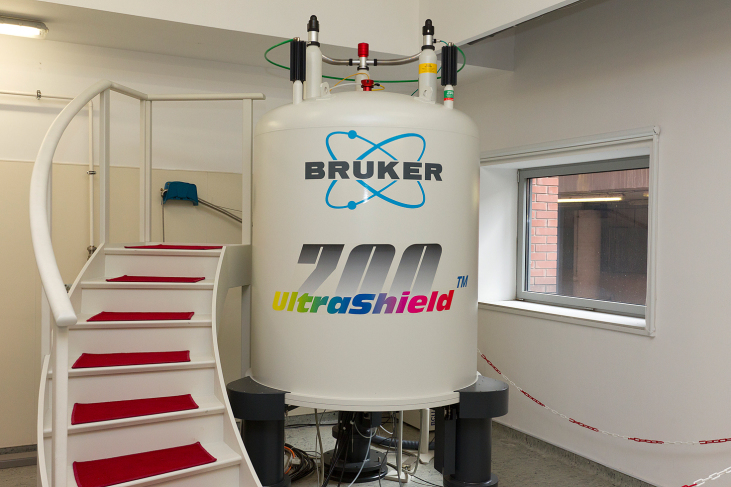Doctoral School of Environmental Sciences

Ghana
Doctoral School of Environmental Sciences
PhD in Environmental Sciences
Degree program
Doctoral
OH-FRKP/406-3/2007
Doctoral School of Environmental Sciences
English
8 semesters (4 years)
240
1
10
Mission statement
The goal of this program is to develop scientific skills necessary to identify and analyze environmental issues. Students will learn critical thinking, problem solving and skeptical inquiry skills and use them to propose solutions to environmental problems.
This program is recommended to applicants who have a solid interest in environmental problems, and has not yet decided her/his specified field of scientific orientation and depending on her/his interest and background knowledge, projects can be shifted to different directions because of their open structure and flexible organization.
This program enables students to join the work of internationally respected research groups. We offer training in up-to-date experimental methods and field exercises besides the solid theoretical background education.
The Doctoral School offers specialized training in the following directions in environmental sciences: environmental biology, environmental chemistry, environmental physics, or environmental geosciences. Emphasis is on the application of the given discipline in complex research projects, such as water quality changes and management, risk analysis and mitigation in various human and natural environments, renewable energy research, etc.
Regulations of the Doctoral School of Environmental Sciences and Quality assurance (Annex 3)
Doctoral Regulations of the Eötvös University and the Faculty of Science (Annex 6/6)
Environmental Biology
Species of the Bacillariophyta division in Chromista kingdom can be found in seas, continental waters and the upper layer of wet soils. During the course we will learn the methods of collection, preparation and identification of this group of organisms. We will briefly review their main groups, their role in aquatic trophic network and their significance in water quality assessment.
-
Microorganisms in nature. Microbes and their micro- and macro environments. Genome size, genetical diversity and the effect of habitats.. Basic concepts of microbial ecology, methods used in microbial ecology. Identification, quantification and methabolic intensity.
-
Connection between biogeography and diversity. Spreading of free living microorganisms, microbial endemism.
-
Developing of biofilms in aquatic habitats. Communication between cells, quorum sensing and evolution. Stability of populations.
-
Interactions between populations (neutral, positive and negative). Interactions between bacteria and viruses. Microbial loops.
-
Microbiology of natural waters (rivers, lakes, seas).
-
Adaptation of microbes to extremophyle environments (temperature, pressure,
...
-
Planning: deciding the subject of the paper (question of originality); choosing the target journal (topics and impact factor); deciding the form of the paper (types of scientific papers).
-
Writing the paper: collecting material (how to use laboratory notes); writing the first draft (literature, most important results, final conclusion); obtaining instructions for the authors; designing tables, figures and other illustrations, copyright questions; how to write the chapters of a paper: Abstract, Introduction, Material and methods, Results, Discussion (their structures, specialities, grammar, expression to avoid); Reference list, Acknowledgements (contribution, technical assistance, financial support); deciding the final title, the running title, the keywords, and the
...
The international environmental scientific and policymaking collaboration have rapidly boosted since the 1970s thanks to the gradually improved observations and enhanced research activities. There is already a comprehensive system of international cooperation that addresses the transboundary and the global environmental problems which include a multitude of institutions, fora, programmes and agreements. Proper understanding of the interrelations and interactions of the scientific and policymaking processes is need for the sake of the development of the adequate responses for the solution of the respective environmental problems and also for the identification of those issues where further research is necessary. After demonstrating the historical development of this cooperation
...
Interactions between plants and soils. Universal physiological aspects of mineral nutrition, mineral deficiency, toxicity. Uptake of essential and toxic elements from the soil, deficiency and toxicity syndromes. Special strategies for mineral uptake. Nutrient uptake in algae, mosses and ferns, non-woody and woody plants. Life strategies based on mineral nutrition. Heavy metal accumulation. Excluder, indicator and accumulator plants. Phytoremediation.
Threats from our cosmic environment. Protective effect of the van-Allen belts of the Earth, geo-magnetosphere, polar lights (aurora). Ozon shield of the Earth, ultraviolet radiation and UV sensitivity. Perm/Trias extinction due to a supernova explosion? Nuclear winter and dinosaur extinction because of a comet impact. Physics and meteorology of lightnings, their physiological effects, ball lightning, red sprites. Ultraviolet paradox of polarization sensitivity. Light pollution. Sunburn of plants by sunlit water droplets. Hearing, noise pollution and injury.
Light polarization, physical base of polarimetry. Biophysics of polarization sensitivity. Polarization-sensitive animals and their behaviour. Polarization patterns of the sky and their atmospheric optical and biological aspects. Reflection-polarization characteristics of water surfaces with biological applications. Polarotactic water detection by aquatic insects. Polarized light pollution. Sky-polarimetric navigation of the Vikings. Circular polarization and its sensation. Why and when is it worth detecting polarization in the ultraviolet, blue and green spectral range? Polarization and colour sensitivity, polarization-induced false colours.
The academic subject analyses the connection between nature and society. It examines the changes in environment paradigm., providing a comprehensive historical analysis of the relation of environment and society, focusing on relations of environment attitudes and behaviour.. Major processes: urbanisation, human ecology, Himalaya-challenge, environment-generated migration, ecological interests and their enforcement. Political ecology, the history of green parties and movements. A transdisciplinar examination of environment.
The distribution of grassland vegetation on the Earth. Major grassland biomes: savanna, llanos, cerrado, pampa, campos, prairie, steppe, grassveld. Grassland vegetation in Hungary. The grasses (Poaceae) as the most important constituents of grasslands: evolution and diversity. Which traits of grasses made these plants the dominant components of grasslands? Other important grassland plants (Apiaceae, Asteraceae, Fabaceae), their special ecological role, functional groups. The climatic determination of grasslands: precipitation and temperature, the role of the amount, timing and predictability of precipitation. Temporary droughts, temperature seasonality: the role of contrasting seasons. Grassland-soil relationships, the physical, chemical and biological properties of grassland
...
1. Special kinds of inland waters. Main hydrological features and communities 1. Soda lakes. 2. Special kinds of inland waters. Main hydrological features and communities
2. Astatic waters, inland saltwaters, brackish, thermal and subterranean waters).
3. Mining lakes (hydrology, biodiversity, succession).
4. Hypotheses regarding running water ecosystems (e.g. river continuum concept).
5. Environmental threats in running waters, biotope restorations.
6. Anthropogenic effects. Impacts of water traffic. Reservoires pro and contra. Importance of introduced and invasive species.
7. Freshwater benthos. Seasonal dynamics of benthic communities. Alteration of vertical pattern of microzoobenthos and protozoobenthos according to the dissolved oxygene content.
8. Origin,
...
The lectures familiarize the audience with the metabolic processes and other activities and effects of microbes, which exert an influence on the status of the environment. This is followed by the review of the principles of environmental (microbial) biotechnological processes (bio stimulation, bio augmentation, bio accumulation, immobilized enzyme- and cell technologies), and the two fundamental and classical environmental biotechnologies, namely composting, and biological water/sewage/sludge treatment. At the end, the conditions, and (biological) safety issues of the „in situ”, on site”, „ex situ” and combined remediation processes are discussed based on case studies. The environmental (bio)analytical techniques frequently used in the pollution assessment and are required to hel
...
The consultations focus on three main topics. Firstly, the role of the regulation; secondly the energy efficiency; thirdly the renewable energy sources and technologies and their spatial aspects.
Wetland types: marine and continental. Marine: coastal, mangrove, coral reefs and estaurine. Continental: rivers and lakes, fluvial landscape, floodplanes. Ecological importance of natural and semi-natural wetland: great species density, huge biodiversity, mosaic-like landscape structure and intensive biomass productivity.
Environmental importance of wetlands: diffuse pollution control by wetlands. Wetlands as water “living filters”. Transforming useless swamps into valuable wetlands. Watershed: implications for the biodiversity. The role of harvest and plant decomposition in constructed wetlands. Phytoremediation processes for water and air pollution control in the aspects of nutrient and carbon dioxide removals. Phytoplankton biomass regulation in contrasting environmental sta
...
Laser diffraction is a well known technique for characterizing particles of sediments/powders but other techniques are also available. First part of the course focuses on the difficulties of the laser diffraction (e.g differences of optical systems, Fraunhoffer vs Mie theory, polydispersity, etc…), second part introduces alternative options for particle characterization: light scattering and static optical particle shape analysis.
Diagnostic properties of soil horizons refer to soil forming processes. Present doctoral course provides an overview about diagnostic properties and diagnostic materials of soils in the context of soil forming. Secondary objective of the course is the comparison of WRB2006 and WRB2014/2015 in the context of soils of the temperate zone.
State of Prokaryotes among living creatures, prokaryotes in nature. Species concept at Prokaryotes. Methods to study bacteria: cultivation and cultivation independent methods. Basics of species description at Prokaryotes, obligatory studied geno – and phenotypic characters, polyphasic taxonomy. Basics of prokaryotic phylogeny, creation of phylogenetic trees, 16S rRNA gene sequencing vs housekeeping genes or whole genome sequencing.
Classification, nomenclature and identification.
The three-domain of life.
Phylogeny, taxonomy and ecology of Archaea.
Phyla of Bacteria domain. Gram positive bacteria, the Actinobacteria and Firmicutes. Taxonomy, characterisation and ecology of Proteobacteria. Phototrophic bacteria (Cyanobacteria, Chloroflexi and Chlorobi). Spirochaetes. P
...
The aim of the course is to acquaint the student with the principles, knowledge, methods, and techniques needed to investigate, understand, and exploit for utilitarian purposes the properties, controlling factors, and manifestations of regional groundwater flow in drainage basins of different orders of magnitude. This knowledge and ability of exploitation is of economic and environmental consequence because gravitational systems of groundwater flow may penetrate several kilometers deep below the surface of the Earth’s terrestrial areas from which zone most of man's subsurface water-needs are satisfied. In addition, a wide range of economically important natural processes occur at or below the land surface that are generated or affected by gravity-driven flow systems.
Identification and determination of organic micro pollutants is crucial in the monitoring and assessment of the environment. Separation science provides indispensable tools in this field. The course can be completed by solving different tasks individually or in small groups. During the semester students also get the opportunity to learn about the solutions of their mates. The subject of the offered tasks fall into the following main topics: Fields of separation science, chromatographic and non-chromatographic methods (ultracentrifugation, electrophoresis…), theories of chromatography, liquid chromatography, gas chromatography, supercritical fluid chromatography, validation of chromatographic methods, sample preparation techniques. Theoretical and practical tasks are both offered
...
There are natural and man-made sources of ionizing radiation in the human environment. These affect populations groups in different manner depending on life style, conditions at work and other factors. During the study of environmental sciences, exposure of people to ionizing radiation may represent an individual agent on one hand, and also a factor of combined environmental effects, on the other hand.
Types of radiation, basic dosimetry terminology, sources and levels of environmental radiation exposure to human, deterministic and stochastic biological effects and health consequences of exposure to ionizing radiation, as well as basic principles of radiation protection and radiohygiene will be presented during the course. Environmental and health consequences of most severe
...
Environmental health deals with the effect of environmental factors (water, soil and air) on human health. The course will introduce the quality requirements of healthy drinking water and bathing water, the health effect of chemical and biological water quality parameters, the characteristic problems of indoor and outdoor air quality and the associated risks, and the human health aspects of soil contamination. The aim of the course is to give an overview of environmental health risks and the national situation of environmental disease burden.
The international conventions were elaborated on those environmental problems which had been identified by the research community by means of environmental observations, analytic methods and models, and which could only be solved by the commitments of all those countries that were responsible for those problems and/or suffered from their adverse impacts. The subjects of the multilateral environmental agreements (MEAs) cover almost all components of the global environment and their large-scale processes. The lectures of this course demonstrate the essence of the most important agreements on environmental elements (atmosphere, transboundary water bodies, biosphere etc.), on human activities influencing the environment and their impacts (through the emission of pollutants,
...
Environmental Physics
Short description of Course: The land-surface (non-vegetated and vegetation-covered surface) and the atmosphere are always interacting. This interaction is to be described by a coupled atmosphere/SVAT (Soil Vegetation Atmosphere Transfer) model system. SVAT models are dealing with exchange processes (e.g. transport of momentum, water vapor, carbon-dioxid, metan, ozone or other trace gas) in the soil-vegetation-atmosphere system. The interaction could be investigated on macroscale (climatological applications) by running coupled GCM(Global Circulation Models)/SVAT model system to get insight into land-surface modulating effects of climate and vice versa. The interaction could also be investigated at smaller scales, for instance, at scales of weather events by running coupled
...
-
Planning: deciding the subject of the paper (question of originality); choosing the target journal (topics and impact factor); deciding the form of the paper (types of scientific papers).
-
Writing the paper: collecting material (how to use laboratory notes); writing the first draft (literature, most important results, final conclusion); obtaining instructions for the authors; designing tables, figures and other illustrations, copyright questions; how to write the chapters of a paper: Abstract, Introduction, Material and methods, Results, Discussion (their structures, specialities, grammar, expression to avoid); Reference list, Acknowledgements (contribution, technical assistance, financial support); deciding the final title, the running title, the keywords, and the
...
The international environmental scientific and policymaking collaboration have rapidly boosted since the 1970s thanks to the gradually improved observations and enhanced research activities. There is already a comprehensive system of international cooperation that addresses the transboundary and the global environmental problems which include a multitude of institutions, fora, programmes and agreements. Proper understanding of the interrelations and interactions of the scientific and policymaking processes is need for the sake of the development of the adequate responses for the solution of the respective environmental problems and also for the identification of those issues where further research is necessary. After demonstrating the historical development of this cooperation
...
This course is made up of laboratory classes with the combined material of lectures, computer demonstrations, team work practices and consultations. Classes are held in blocks. Students are expected to solve subject-related problems independently, based on which skill they are required to write an essay at the end of the semester. In the first part of the semester students learn the theoretical aspects of the material and have computer demonstrations. During the second half of the semester they work in teams to solve subject- related problems and are also provided the opportunity for personal consultation.
Topics:
-
Methodology of ecological researches and the importance of the Tropics.
-
Climate system and biogeography of the Tropics
-
Stuctural questions of community
...
The academic subject analyses the connection between nature and society. It examines the changes in environment paradigm., providing a comprehensive historical analysis of the relation of environment and society, focusing on relations of environment attitudes and behaviour.. Major processes: urbanisation, human ecology, Himalaya-challenge, environment-generated migration, ecological interests and their enforcement. Political ecology, the history of green parties and movements. A transdisciplinar examination of environment.
Effects of Earth’s rotation (Coriolis and centrifugal forces), Navier-Stokes equation in rotating reference frames, dimensionless form of equations, Rossby number, Froude number, dynamical pressure, geostrophic equilibrium, Taylor-Proudman theorem, linearization of the equations, wave phenomena in rotating fluids, shallow water equations, conservation of potential vorticity, effects of surface curvature, Ekman boundary layers, effects of density stratification, thermal wind, Boussinesq approximation, baroclinic instability.
Deposition models (big-leaf models, multi-layer models). Parameterizations. Input datasets. Uncertainty of model parameters. Deposition of nitrogen, sulphur components. Deposition of tropospheric ozone. Model calibration and verification.
The consultations focus on three main topics. Firstly, the role of the regulation; secondly the energy efficiency; thirdly the renewable energy sources and technologies and their spatial aspects.
The course focuses on the geochemical processes beneath and on the surface of the Earth, which drive and control cycles of chemical elements. Each element has a characteristic geochemical cycle that reflects its particular set of geochemical properties. The geochemical cycles of the elements have influences the environments beneath and on the surface of the Earth and have been affected by changes that have occurred in and on the Earth. Course prerequisites are basic chemistry, physics, biology and earth sciences.
Laser diffraction is a well known technique for characterizing particles of sediments/powders but other techniques are also available. First part of the course focuses on the difficulties of the laser diffraction (e.g differences of optical systems, Fraunhoffer vs Mie theory, polydispersity, etc…), second part introduces alternative options for particle characterization: light scattering and static optical particle shape analysis.
Diagnostic properties of soil horizons refer to soil forming processes. Present doctoral course provides an overview about diagnostic properties and diagnostic materials of soils in the context of soil forming. Secondary objective of the course is the comparison of WRB2006 and WRB2014/2015 in the context of soils of the temperate zone.
-
Introduction to mathematical-geoinformatical modelling of surfaces
-
The elevation as a model, sampling theory, DEM, DTM, DSM, OHM(nDSM)
-
The digital elevation model, raster and vector models
-
Classic methods of gathering digital elevation data
-
Stereo photogrammetry
-
Laser scanning (LiDAR) and other active remote sensing methods
-
Interpolation in digital elevation and surface modelling
-
The effect of the canopy on the digital data gathering
-
Global and local elevation models, SRTM, MOLA, HRSC DTM
-
Modelling microtopography
-
Fractal properties of surfaces and their digital modelling
-
Application of digital elevation and surface models
After the review of basic concepts of the meteorology and air quality modelling we analyse the hydro-thermodynamic equation system of atmosphere and air pollution transport equation. We’ll study the structure of atmospheric turbulence, concern with various order closure hypotheses. We’ll review the classification of the dispersion models (statistic and dynamic, Lagrange and Euler types, etc.). Construction of local and mesoscale air pollution and PBL models are also investigated. Air pollution model applications in Hungary especially in the Hungarian Meteorological Service will be investigated in the end of the course.
The aim of the course is to acquaint the student with the principles, knowledge, methods, and techniques needed to investigate, understand, and exploit for utilitarian purposes the properties, controlling factors, and manifestations of regional groundwater flow in drainage basins of different orders of magnitude. This knowledge and ability of exploitation is of economic and environmental consequence because gravitational systems of groundwater flow may penetrate several kilometers deep below the surface of the Earth’s terrestrial areas from which zone most of man's subsurface water-needs are satisfied. In addition, a wide range of economically important natural processes occur at or below the land surface that are generated or affected by gravity-driven flow systems.
The results of combustion science are widely used for improving the efficiency of combustion processes and decreasing the environmental load. The most important results are the continously lower fuel consumption of vehicles, the reduced of pollution emission from traffic, and the production of more electricity with less CO2 emission. Engineering optimization of combustion processes is one of the most important practical applications of modern reaction kinetics.
General characterization of off-line (HPLC-GF-AAS, HPLC-TXRF, TLC/OPLC-TXRF, TLC-LA-ICP-MS) and on-line techniques (HPLC-FAAS, HPLC-ICP-AES, HPLC-ICP-MS, GC-AAS, LC-QF-AAS) for element speciation in environmental chemistry; speciation of As, Cd, Cr, Hg, Ni, Pb and Sn in environment. Detailed course outline: 1. Reasons for doing elemental speciation; 2. Sampling strategies for elemental speciation: sampling of environmental samples; 3. Sampling strategies for elemental speciation: sampling of clinical samples; 4. Sample preparation for elemental speciation: derivatization and pre-concentration methods;5. Hyphenation techniques for volatile samples (GC as separation technique); 6. Hyphenation techniques for liquid samples (HPLC and CE as separation techniques); 7. Speciation
...
There are natural and man-made sources of ionizing radiation in the human environment. These affect populations groups in different manner depending on life style, conditions at work and other factors. During the study of environmental sciences, exposure of people to ionizing radiation may represent an individual agent on one hand, and also a factor of combined environmental effects, on the other hand.
Types of radiation, basic dosimetry terminology, sources and levels of environmental radiation exposure to human, deterministic and stochastic biological effects and health consequences of exposure to ionizing radiation, as well as basic principles of radiation protection and radiohygiene will be presented during the course. Environmental and health consequences of most severe
...
The international conventions were elaborated on those environmental problems which had been identified by the research community by means of environmental observations, analytic methods and models, and which could only be solved by the commitments of all those countries that were responsible for those problems and/or suffered from their adverse impacts. The subjects of the multilateral environmental agreements (MEAs) cover almost all components of the global environment and their large-scale processes. The lectures of this course demonstrate the essence of the most important agreements on environmental elements (atmosphere, transboundary water bodies, biosphere etc.), on human activities influencing the environment and their impacts (through the emission of pollutants,
...
Environmental Chemistry
-
Planning: deciding the subject of the paper (question of originality); choosing the target journal (topics and impact factor); deciding the form of the paper (types of scientific papers).
-
Writing the paper: collecting material (how to use laboratory notes); writing the first draft (literature, most important results, final conclusion); obtaining instructions for the authors; designing tables, figures and other illustrations, copyright questions; how to write the chapters of a paper: Abstract, Introduction, Material and methods, Results, Discussion (their structures, specialities, grammar, expression to avoid); Reference list, Acknowledgements (contribution, technical assistance, financial support); deciding the final title, the running title, the keywords, and the
...
Introduces students to definitions and sampling methods of natural seed banks. Discusses seed longevity studies and further issues on seed (fruit) viability, and deals with soil seed bank types, and their classification. A second part of the course offers a comprehensive overview of the recent knowledge on the role and importance of natural seed banks in the dinamic processes of vegetation, e.g. succession, degradation, habitat restauration. At the end of the course seed bank databases, seed ecological databases and their applicability is demonstrated.
The international environmental scientific and policymaking collaboration have rapidly boosted since the 1970s thanks to the gradually improved observations and enhanced research activities. There is already a comprehensive system of international cooperation that addresses the transboundary and the global environmental problems which include a multitude of institutions, fora, programmes and agreements. Proper understanding of the interrelations and interactions of the scientific and policymaking processes is need for the sake of the development of the adequate responses for the solution of the respective environmental problems and also for the identification of those issues where further research is necessary. After demonstrating the historical development of this cooperation
...
Threats from our cosmic environment. Protective effect of the van-Allen belts of the Earth, geo-magnetosphere, polar lights (aurora). Ozon shield of the Earth, ultraviolet radiation and UV sensitivity. Perm/Trias extinction due to a supernova explosion? Nuclear winter and dinosaur extinction because of a comet impact. Physics and meteorology of lightnings, their physiological effects, ball lightning, red sprites. Ultraviolet paradox of polarization sensitivity. Light pollution. Sunburn of plants by sunlit water droplets. Hearing, noise pollution and injury.
Light polarization, physical base of polarimetry. Biophysics of polarization sensitivity. Polarization-sensitive animals and their behaviour. Polarization patterns of the sky and their atmospheric optical and biological aspects. Reflection-polarization characteristics of water surfaces with biological applications. Polarotactic water detection by aquatic insects. Polarized light pollution. Sky-polarimetric navigation of the Vikings. Circular polarization and its sensation. Why and when is it worth detecting polarization in the ultraviolet, blue and green spectral range? Polarization and colour sensitivity, polarization-induced false colours.
The academic subject analyses the connection between nature and society. It examines the changes in environment paradigm., providing a comprehensive historical analysis of the relation of environment and society, focusing on relations of environment attitudes and behaviour.. Major processes: urbanisation, human ecology, Himalaya-challenge, environment-generated migration, ecological interests and their enforcement. Political ecology, the history of green parties and movements. A transdisciplinar examination of environment.
The consultations focus on three main topics. Firstly, the role of the regulation; secondly the energy efficiency; thirdly the renewable energy sources and technologies and their spatial aspects.
The course focuses on the geochemical processes beneath and on the surface of the Earth, which drive and control cycles of chemical elements. Each element has a characteristic geochemical cycle that reflects its particular set of geochemical properties. The geochemical cycles of the elements have influences the environments beneath and on the surface of the Earth and have been affected by changes that have occurred in and on the Earth. Course prerequisites are basic chemistry, physics, biology and earth sciences.
Laser diffraction is a well known technique for characterizing particles of sediments/powders but other techniques are also available. First part of the course focuses on the difficulties of the laser diffraction (e.g differences of optical systems, Fraunhoffer vs Mie theory, polydispersity, etc…), second part introduces alternative options for particle characterization: light scattering and static optical particle shape analysis.
Diagnostic properties of soil horizons refer to soil forming processes. Present doctoral course provides an overview about diagnostic properties and diagnostic materials of soils in the context of soil forming. Secondary objective of the course is the comparison of WRB2006 and WRB2014/2015 in the context of soils of the temperate zone.
The aim of the course is to acquaint the student with the principles, knowledge, methods, and techniques needed to investigate, understand, and exploit for utilitarian purposes the properties, controlling factors, and manifestations of regional groundwater flow in drainage basins of different orders of magnitude. This knowledge and ability of exploitation is of economic and environmental consequence because gravitational systems of groundwater flow may penetrate several kilometers deep below the surface of the Earth’s terrestrial areas from which zone most of man's subsurface water-needs are satisfied. In addition, a wide range of economically important natural processes occur at or below the land surface that are generated or affected by gravity-driven flow systems.
The results of combustion science are widely used for improving the efficiency of combustion processes and decreasing the environmental load. The most important results are the continously lower fuel consumption of vehicles, the reduced of pollution emission from traffic, and the production of more electricity with less CO2 emission. Engineering optimization of combustion processes is one of the most important practical applications of modern reaction kinetics.
General characterization of off-line (HPLC-GF-AAS, HPLC-TXRF, TLC/OPLC-TXRF, TLC-LA-ICP-MS) and on-line techniques (HPLC-FAAS, HPLC-ICP-AES, HPLC-ICP-MS, GC-AAS, LC-QF-AAS) for element speciation in environmental chemistry; speciation of As, Cd, Cr, Hg, Ni, Pb and Sn in environment. Detailed course outline: 1. Reasons for doing elemental speciation; 2. Sampling strategies for elemental speciation: sampling of environmental samples; 3. Sampling strategies for elemental speciation: sampling of clinical samples; 4. Sample preparation for elemental speciation: derivatization and pre-concentration methods;5. Hyphenation techniques for volatile samples (GC as separation technique); 6. Hyphenation techniques for liquid samples (HPLC and CE as separation techniques); 7. Speciation
...
Identification and determination of organic micro pollutants is crucial in the monitoring and assessment of the environment. Separation science provides indispensable tools in this field. The course can be completed by solving different tasks individually or in small groups. During the semester students also get the opportunity to learn about the solutions of their mates. The subject of the offered tasks fall into the following main topics: Fields of separation science, chromatographic and non-chromatographic methods (ultracentrifugation, electrophoresis…), theories of chromatography, liquid chromatography, gas chromatography, supercritical fluid chromatography, validation of chromatographic methods, sample preparation techniques. Theoretical and practical tasks are both offered
...
There are natural and man-made sources of ionizing radiation in the human environment. These affect populations groups in different manner depending on life style, conditions at work and other factors. During the study of environmental sciences, exposure of people to ionizing radiation may represent an individual agent on one hand, and also a factor of combined environmental effects, on the other hand.
Types of radiation, basic dosimetry terminology, sources and levels of environmental radiation exposure to human, deterministic and stochastic biological effects and health consequences of exposure to ionizing radiation, as well as basic principles of radiation protection and radiohygiene will be presented during the course. Environmental and health consequences of most severe
...
Environmental health deals with the effect of environmental factors (water, soil and air) on human health. The course will introduce the quality requirements of healthy drinking water and bathing water, the health effect of chemical and biological water quality parameters, the characteristic problems of indoor and outdoor air quality and the associated risks, and the human health aspects of soil contamination. The aim of the course is to give an overview of environmental health risks and the national situation of environmental disease burden.
The international conventions were elaborated on those environmental problems which had been identified by the research community by means of environmental observations, analytic methods and models, and which could only be solved by the commitments of all those countries that were responsible for those problems and/or suffered from their adverse impacts. The subjects of the multilateral environmental agreements (MEAs) cover almost all components of the global environment and their large-scale processes. The lectures of this course demonstrate the essence of the most important agreements on environmental elements (atmosphere, transboundary water bodies, biosphere etc.), on human activities influencing the environment and their impacts (through the emission of pollutants,
...
This course is made up of laboratory classes with the combined material of lectures, computer demonstrations, team work practices and consultations. Classes are held in blocks. Students are expected to solve subject-related problems independently, based on which skill they are required to write an essay at the end of the semester. In the first part of the semester students learn the theoretical aspects of the material and have computer demonstrations. During the second half of the semester they work in teams to solve subject- related problems and are also provided the opportunity for personal consultation.
Topics:
-
Methodology of ecological researches and the importance of the Tropics.
-
Climate system and biogeography of the Tropics
-
Stuctural questions of community
...
Environmental Earth Sciences
Short description of Course: The land-surface (non-vegetated and vegetation-covered surface) and the atmosphere are always interacting. This interaction is to be described by a coupled atmosphere/SVAT (Soil Vegetation Atmosphere Transfer) model system. SVAT models are dealing with exchange processes (e.g. transport of momentum, water vapor, carbon-dioxid, metan, ozone or other trace gas) in the soil-vegetation-atmosphere system. The interaction could be investigated on macroscale (climatological applications) by running coupled GCM(Global Circulation Models)/SVAT model system to get insight into land-surface modulating effects of climate and vice versa. The interaction could also be investigated at smaller scales, for instance, at scales of weather events by running coupled
...
-
Planning: deciding the subject of the paper (question of originality); choosing the target journal (topics and impact factor); deciding the form of the paper (types of scientific papers).
-
Writing the paper: collecting material (how to use laboratory notes); writing the first draft (literature, most important results, final conclusion); obtaining instructions for the authors; designing tables, figures and other illustrations, copyright questions; how to write the chapters of a paper: Abstract, Introduction, Material and methods, Results, Discussion (their structures, specialities, grammar, expression to avoid); Reference list, Acknowledgements (contribution, technical assistance, financial support); deciding the final title, the running title, the keywords, and the
...
The international environmental scientific and policymaking collaboration have rapidly boosted since the 1970s thanks to the gradually improved observations and enhanced research activities. There is already a comprehensive system of international cooperation that addresses the transboundary and the global environmental problems which include a multitude of institutions, fora, programmes and agreements. Proper understanding of the interrelations and interactions of the scientific and policymaking processes is need for the sake of the development of the adequate responses for the solution of the respective environmental problems and also for the identification of those issues where further research is necessary. After demonstrating the historical development of this cooperation
...
Threats from our cosmic environment. Protective effect of the van-Allen belts of the Earth, geo-magnetosphere, polar lights (aurora). Ozon shield of the Earth, ultraviolet radiation and UV sensitivity. Perm/Trias extinction due to a supernova explosion? Nuclear winter and dinosaur extinction because of a comet impact. Physics and meteorology of lightnings, their physiological effects, ball lightning, red sprites. Ultraviolet paradox of polarization sensitivity. Light pollution. Sunburn of plants by sunlit water droplets. Hearing, noise pollution and injury.
Light polarization, physical base of polarimetry. Biophysics of polarization sensitivity. Polarization-sensitive animals and their behaviour. Polarization patterns of the sky and their atmospheric optical and biological aspects. Reflection-polarization characteristics of water surfaces with biological applications. Polarotactic water detection by aquatic insects. Polarized light pollution. Sky-polarimetric navigation of the Vikings. Circular polarization and its sensation. Why and when is it worth detecting polarization in the ultraviolet, blue and green spectral range? Polarization and colour sensitivity, polarization-induced false colours.
This course is made up of laboratory classes with the combined material of lectures, computer demonstrations, team work practices and consultations. Classes are held in blocks. Students are expected to solve subject-related problems independently, based on which skill they are required to write an essay at the end of the semester. In the first part of the semester students learn the theoretical aspects of the material and have computer demonstrations. During the second half of the semester they work in teams to solve subject- related problems and are also provided the opportunity for personal consultation.
Topics:
-
Methodology of ecological researches and the importance of the Tropics.
-
Climate system and biogeography of the Tropics
-
Stuctural questions of community
...
The academic subject analyses the connection between nature and society. It examines the changes in environment paradigm., providing a comprehensive historical analysis of the relation of environment and society, focusing on relations of environment attitudes and behaviour.. Major processes: urbanisation, human ecology, Himalaya-challenge, environment-generated migration, ecological interests and their enforcement. Political ecology, the history of green parties and movements. A transdisciplinar examination of environment.
Goals of the course:
• To give an introduction into R, a freely available statistical and computational environment, which is widely used by scientists all over the world.
• To change the perspective of the students on statistics. In particular that data are realizations of random variables and thus descriptive statistics, which depend on the data, are also random variables.
Syllabus:
Introduction to R, in particular its basic commands, possibilities for reading in data, storing and preprocessing them, basics of graphical tools. The subsequent goal is to introduce and apply univariate data analysis methods in R covering the following topics:
- statistical sample, basic statistics
-requirements of estimation
-histograms, distributions and their assessment
- box-and-whiskers pl
...
Unique behaviour of karst. Karst as geomorphological and hydrogeological term. Interpretation of epigenic and hypogenic karst. Specific methods and approaches of Karst system studies
Terms of the voulneralibity. Importance of karst voulneralibity. Methods and its historical developement and classification. Examples of karst voulneralibity studies.. Importance of validation.
The consultations focus on three main topics. Firstly, the role of the regulation; secondly the energy efficiency; thirdly the renewable energy sources and technologies and their spatial aspects.
The course focuses on the geochemical processes beneath and on the surface of the Earth, which drive and control cycles of chemical elements. Each element has a characteristic geochemical cycle that reflects its particular set of geochemical properties. The geochemical cycles of the elements have influences the environments beneath and on the surface of the Earth and have been affected by changes that have occurred in and on the Earth. Course prerequisites are basic chemistry, physics, biology and earth sciences.
Wetland types: marine and continental. Marine: coastal, mangrove, coral reefs and estaurine. Continental: rivers and lakes, fluvial landscape, floodplanes. Ecological importance of natural and semi-natural wetland: great species density, huge biodiversity, mosaic-like landscape structure and intensive biomass productivity.
Environmental importance of wetlands: diffuse pollution control by wetlands. Wetlands as water “living filters”. Transforming useless swamps into valuable wetlands. Watershed: implications for the biodiversity. The role of harvest and plant decomposition in constructed wetlands. Phytoremediation processes for water and air pollution control in the aspects of nutrient and carbon dioxide removals. Phytoplankton biomass regulation in contrasting environmental sta
...
Laser diffraction is a well known technique for characterizing particles of sediments/powders but other techniques are also available. First part of the course focuses on the difficulties of the laser diffraction (e.g differences of optical systems, Fraunhoffer vs Mie theory, polydispersity, etc…), second part introduces alternative options for particle characterization: light scattering and static optical particle shape analysis.
Diagnostic properties of soil horizons refer to soil forming processes. Present doctoral course provides an overview about diagnostic properties and diagnostic materials of soils in the context of soil forming. Secondary objective of the course is the comparison of WRB2006 and WRB2014/2015 in the context of soils of the temperate zone.
-
Introduction to mathematical-geoinformatical modelling of surfaces
-
The elevation as a model, sampling theory, DEM, DTM, DSM, OHM(nDSM)
-
The digital elevation model, raster and vector models
-
Classic methods of gathering digital elevation data
-
Stereo photogrammetry
-
Laser scanning (LiDAR) and other active remote sensing methods
-
Interpolation in digital elevation and surface modelling
-
The effect of the canopy on the digital data gathering
-
Global and local elevation models, SRTM, MOLA, HRSC DTM
-
Modelling microtopography
-
Fractal properties of surfaces and their digital modelling
-
Application of digital elevation and surface models
After the review of basic concepts of the meteorology and air quality modelling we analyse the hydro-thermodynamic equation system of atmosphere and air pollution transport equation. We’ll study the structure of atmospheric turbulence, concern with various order closure hypotheses. We’ll review the classification of the dispersion models (statistic and dynamic, Lagrange and Euler types, etc.). Construction of local and mesoscale air pollution and PBL models are also investigated. Air pollution model applications in Hungary especially in the Hungarian Meteorological Service will be investigated in the end of the course.
Importance of geothermal energy around the world, future prognoses. Geothermal systems. Natural geothermal systems and their character. Geothermal potential of Hungary. Assessment of heat flux. Processes influencing heat flux. Karstic and porous geothermal systems. Issues of sustainable thermal water production. Artificially influenced systems: doublet systems, EGS, geothermal heat pumps. Classification and use of geothermal energy. Basics of geothermal reconnaissance. Geophysical and geochemical methods applied to geothermal exploration. Geothermal resource assessment. Geothermal power generation, direct heat utilisation, waste heat utilisation. Environmental and legal issues. Economic, environmental and social issues.
There are natural and man-made sources of ionizing radiation in the human environment. These affect populations groups in different manner depending on life style, conditions at work and other factors. During the study of environmental sciences, exposure of people to ionizing radiation may represent an individual agent on one hand, and also a factor of combined environmental effects, on the other hand.
Types of radiation, basic dosimetry terminology, sources and levels of environmental radiation exposure to human, deterministic and stochastic biological effects and health consequences of exposure to ionizing radiation, as well as basic principles of radiation protection and radiohygiene will be presented during the course. Environmental and health consequences of most severe
...
This course presents and explore the use and application of ostracod studies in palaeoenvironmental reconstruction. The preparation methods of their carapaces, the skeletal anatomy, taxonomy, biology and mode of life of ostracods will be reviewed. With the help of case studies applications of ostracod faunas in palaeoecology, palaeoceanography and environmental science will be featured.
This course presents and explore the application of palaeontological, sedimentological and geochemical methods in palaeoenvironmental reconstruction of marine systems. The palaeoecological significance of different marine fossils, the microfacies studies and geochemical analyses of fossil skeletons in palaeoenvironmental reconstruction will be featured with the help of case studies.
The international conventions were elaborated on those environmental problems which had been identified by the research community by means of environmental observations, analytic methods and models, and which could only be solved by the commitments of all those countries that were responsible for those problems and/or suffered from their adverse impacts. The subjects of the multilateral environmental agreements (MEAs) cover almost all components of the global environment and their large-scale processes. The lectures of this course demonstrate the essence of the most important agreements on environmental elements (atmosphere, transboundary water bodies, biosphere etc.), on human activities influencing the environment and their impacts (through the emission of pollutants,
...
Our doctoral graduates find employment in various places such as environmental companies and organizations, governmental bodies and agencies, international organizations dealing with cross-border environmental activities, and many others in education.
Aerospace Engineer, Anthropologist, Architectural Historian, Asbestos Abatement Manager, Astronomer, Atmospheric Dispersion Modeler, Atmospheric Scientist, Chemical Oceanographer, Decontamination Technician, Emergency Disaster Response Technician, Environmental Biologist, Environmental Biotechnology, Environmental Chemist, Environmental Data Analyst, Environmental Engineer, Environmental Geologist, Environmental Health Safety Manager, Environmental Health Safety Trainer, Environmental Monitor, Environmental Psychologist, Environmental Sampling Technician, Environmental Writer, Fire Fuel Manager, Fire Protection Engineer, Fire Safety Specialist, Forensic Biologist, Forensic Scientist, Geological Oceanographer, Geologist, Geomagnetist, Geomorphologist, Geophysicist, Groundwater Sampling Technician, Habitat Restoration Engineer, Health Safety Engineer, Herpetologist, Historian, Hydrogeologist, Hydrologist, Ichthyologist, Immunologist, Industrial Hygienist, Integrated Water Resources Manager, Invertebrate Biologist, Lab Technician, Land Acquisition Manager, Lead Abatement Technician, Mammalogist, Marine Biologist, Metallurgist, Meteorologist, Microbiologist, Mineralogist, Mining Engineer, Mining Surveyor, Molecular Biologist, Nepa Ceqa Manager, Oceanographer, Ornithologist, Paleobiologist, Paleontologist, Paleozoologist, Petroleum Technician, Physicist, Primatologist, Remote Sensing Specialist, Seismologist, Volcanologist, Wildlife Biologist, Zoologist
1,910 EUR
3,000 - 5.000 EUR (depending on the research topic)
9000 HUF (non-refundable)
160 EUR (non-refundable)
3,000 - 5.000 EUR (depending on the research topic)
160 EUR (non-refundable)
Yes
01, Sep, 2025
31, May, 2025
No
Entry requirements
A master’s degree in science is a requirement.
Language requirements
An internationally accredited language examination is required with at least a B2 CEFR level or equivalent result.
Examples of minimum level accepted:
TOEFL iBT 72 pts
IELTS 5.5
Alternatively, an official certificate issued by the applicant’s previous higher education institution can be accepted, stating that the applicant’s previous education (Bachelor’s or Master’s degree) was completed entirely in English.
| Document |
| Online application form |
| Bachelor-level degree (optional) |
| Master-level degree |
| Transcript of records |
| CV |
| Research plan |
| Statement of Supervisor |
| Language certificate |
| Proof of application fee transfer |
| Motivation letter (optional) |
| Letter of recommendation (optional) |
| Copy of the main pages of the passport (optional) |
| Passport photo (optional) |
| Medical certificate (optional) |
The application starts at the online application system. Students need to register in the system, fill in the online application form, upload the required documents and follow the instructions during the application process.
Well before the deadline, applicants should contact the supervisor whose topic they have chosen,to find out if their knowledge and research experience are relevant to the subject. If so, the applicant needs to agree on the outlines of the research with the supervisor and is required to make a research plan approved by the supervisor.
Procedure of the entrance examination:
The applications are examined by the Admission Board during May and June and applicants are notified of the outcome of the selection in the online application system in July. Admission letters are sent out in the online application system until August 1. In case of February intake, admission letters are sent out in the online application system December 1.
Type of entrance examination: oral
Place of entrance examination: Skype interview (Skype identifier is demanded)
Criteria for ranking at the admission procedure shall include:
-
previous university achievement (examinations, comprehensive examinations, qualification of degree)
-
achievements related to previous research work (awards obtained in students’ academic circles, publications in the particular professional area)
Prof. Tamás TURÁNYI
Head of the Doctoral School
International Coordinator
Mr. Péter MOLNÁR
inter@ttk.elte.hu
TEL: +36-1-372-2695
More information
Faculty website
Faculty of Science
Faculty of Science
Eötvös Loránd University (ELTE) offers more than 60 degree programs in foreign languages in the fields of Education and Psychology, Humanities, Informatics, Law, Social Sciences and Science. Currently, about 2400 international students study at ELTE and the community of international students is growing from year to year. Check out what our international students think and discover the wide-range of opportunities waiting for you at ELTE. Join the growing international community of ELTE.
Eötvös Loránd University (ELTE) offers more than 60 degree programs in foreign languages in the fields of Education and Psychology, Humanities, Informatics, Law, Social Sciences and Science. Currently, about 2400 international students study at ELTE and the community of international students is growing from year to year. Check out what our international students think and discover the wide-range of opportunities waiting for you at ELTE. Join the growing international community of ELTE.
0
/
0





















0
/
0



